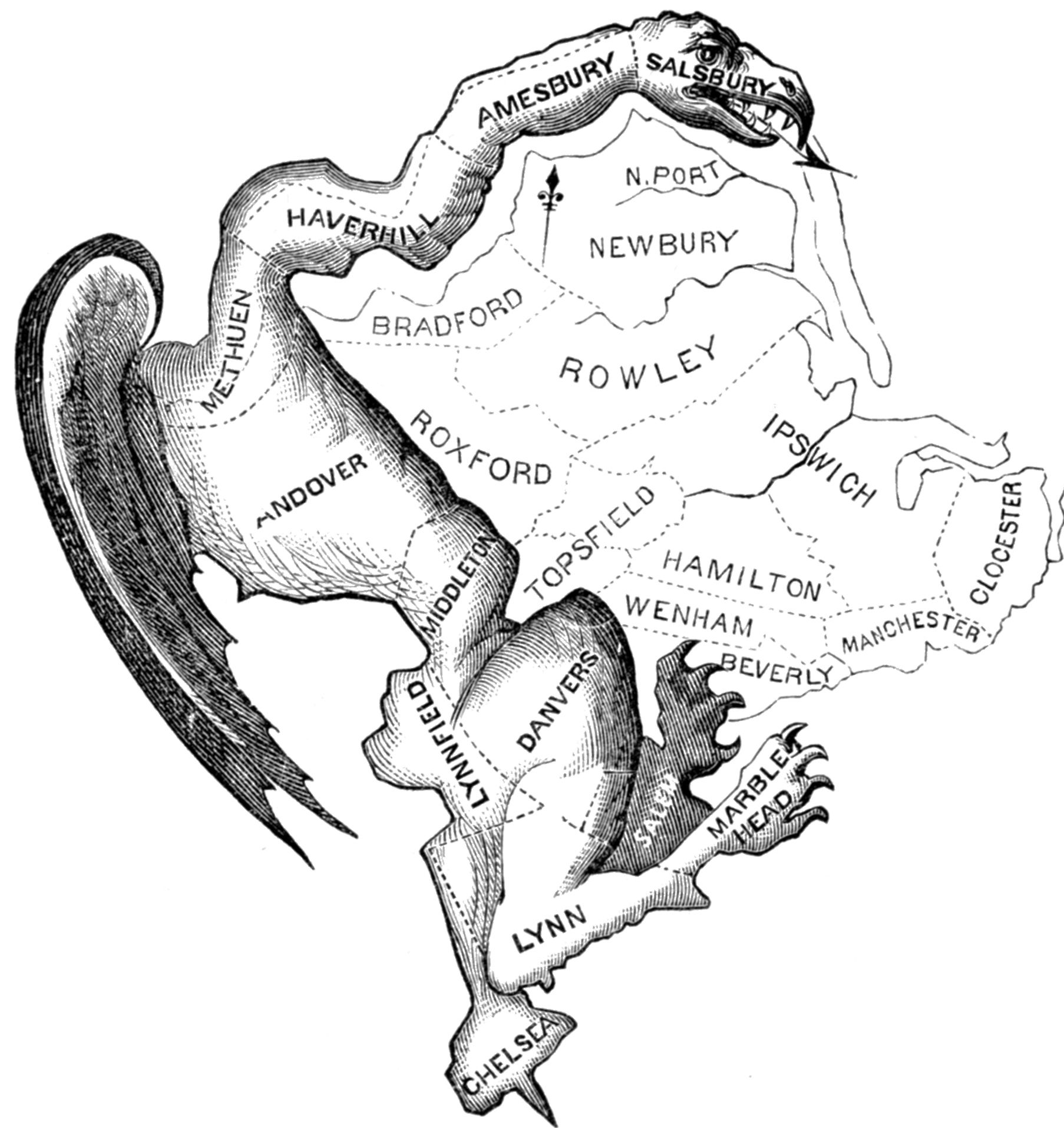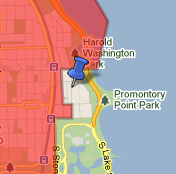What is the most likely explanation for a congressional district to change shape?
Why should we intendance?
The location of commune lines make up one's mind which voters vote for which representative. Changing the lines will change the relevant voters, and tin can change the identity, fidelity, and political priorities of a district's representative, and of the legislative delegation equally a whole.
Click on the wheel to see how. 
American attempts to tailor commune lines for political proceeds stretch back to the state'southward very origin. Patrick Henry, who opposed the new Constitution, tried to draw district lines to deny a seat in the outset Congress to James Madison, the Constitution's primary author. Henry ensured that Madison's district was drawn to include counties politically opposed to Madison. The endeavor failed, and Madison was elected — but the American gerrymander had begun.

Ironically, the man who inspired the term "gerrymander" served under Madison, the practice's first American target. Just a few months before Elbridge Gerry became Madison's vice president, as the Democratic-Republican governor of Massachusetts, Gerry signed a redistricting plan that was thought to ensure his party's domination of the Massachusetts state senate. An editorial creative person added wings, claws, and the head of a particularly fierce-looking salamander brute to the outline of one peculiarly notable district grouping towns in the northeast of the land; the beast was dubbed the "Gerry-mander" in the press, and the practice of changing the district lines to affect political ability has kept the name ever since.
It's worth noting that the shape of the "Gerry-mander" isn't that odd in the abstract. The district is only a collection of the towns ringing Essex Canton. The reason the editorial cartoonist gave information technology wings, claws, and a caput isn't really well-nigh how it looked, but what information technology was doing: trying to secure partisan victory in a way that opponents idea illegitimate. How a district looks is rarely a guide to whether it's good or bad: there are "pretty" districts that requite awful representation, and "ugly" districts that give wonderful representation.
In well-nigh states, the gerrymander is alive and well, doing bad things. Politicians nevertheless cleave territory into districts for political gain, usually along partisan lines. This tin can lead to some serious consequences for the health of the commonwealth:
Locking up power
Until Proffer 11 was passed in 2008, California'due south redistricting system was controlled by the state legislature. Under this system, later on the 2000 census, the major political parties effectively decided to phone call a truce, and to proceed the congressional incumbents of both parties rubber from effective challenges. Many incumbents each paid a consultant at least $xx,000 to have their districts custom-designed for safe. As one member of Congress explained: "Twenty 1000 is nothing to keep your seat. I spend $2 one thousand thousand (candidature) every year. If my colleagues are smart, they'll pay their $twenty,000, and [our consultant] will draw the district they can win in. Those who take refused to pay? God help them." In the adjacent election, every unmarried incumbent, Republican and Democrat, won by more xx% . . . except for the one whose margin of victory was 19%.
Eliminating incumbents
Subsequently the 2000 elections in Virginia, the Republicans who controlled the redistricting procedure targeted Richard Cranwell, the Autonomous leader in the state Firm of Delegates, who had represented his constituents for 29 years. They surgically carved his firm out of the district he had represented, and placed information technology in the commune of his 22-year colleague, Democrat Bit Woodrum. Woodrum's district looked similar it had a tiny grasping hand reaching out to grab Cranwell's abode. Rather than run against the hometown favorite in an unfamiliar district, Cranwell decided non to run for reelection.
And in New York, in 2022, the Democratic Speaker of the New York Assembly allegedly used the redistricting procedure to target a romantic rival, Republican and former Minority Whip Dan Burling. Speaker Sheldon Silverish was allegedly having an affair with a member of the Assembly, and apparently discovered that Burling was as well having an thing, with the same representative. (Despite coexisting testify produced in court, at that place have been some heated denials from the parties involved.) When it came time for redistricting, the district Burling had represented was shifted substantially due west, to include a pop up-and-coming Republican mayor; Burling retired rather than face the chief challenge. Four years subsequently, Silver was convicted on federal corruption charges.
Eliminating challengers
In the 2000 primary for an Illinois congressional seat, then-state Senator Barack Obama threw together a hasty campaign confronting a sympathetic incumbent, and won more than 30% of the vote. Though Obama lost, his entrada set up the stage for a stronger showing in a potential rematch.

 When Illinois redrew its districts, the state legislators deferred to incumbent members of Congress, including the incumbent whom Obama challenged. When the redistricting was washed, the block effectually Obama's home was carved out of the district (click hither for the 2000 map, and here for the 2002 map, or click on the images to the right). Obama would accept been forced to sell his home and motion in order to live in the commune where he had run 2 years before.
When Illinois redrew its districts, the state legislators deferred to incumbent members of Congress, including the incumbent whom Obama challenged. When the redistricting was washed, the block effectually Obama's home was carved out of the district (click hither for the 2000 map, and here for the 2002 map, or click on the images to the right). Obama would accept been forced to sell his home and motion in order to live in the commune where he had run 2 years before.
Extreme partisan proceeds
North Carolina is a deeply divided royal state: in 2008, the Presidential race split 50-50; in 2022, it split 51-49; in 2022, information technology split 52-48. Only when the state legislature, unilaterally controlled by Republicans, sought to redraw congressional lines in 2022 after a courtroom struck down an before programme, the committee chair said "I propose that we depict the maps to give a partisan advantage to 10 Republicans and 3 Democrats." Why such a lopsided effect? "[B]ecause I do not believe it's possible to draw a map with 11 Republicans and 2 Democrats," he said.
In Maryland in 2022, Democrats aimed in the opposite management. The Democratic Governor — who drew the map that was then ratified by the Democratic legislature — testified that he "fix out to draw the borders in a way that was favorable to the Democratic party." And they were successful, lavishing item attention on a district in western Maryland to ensure that Democrats won 7 of the land'due south 8 congressional seats.
Diluting minority votes
Later on Democrats controlled Texas redistricting in the 1990s, Republicans took charge in 2003. The redistricting battles were so fierce that Democratic legislators actually fled to Oklahoma and New Mexico in an endeavour to prevent the legislature from meeting to draw lines. (The Democrats hid out in Oklahoma in a Holiday Inn, under assumed names. A police force student reviewed the episode in a paper, beginning: "Historically, at that place are many reasons why middle-aged men might sneak into a motel tardily at night. Until at present, redistricting has not been one of them."
When the lines were ultimately fatigued, they moved about 100,000 Latino voters out of one district in order to protect an incumbent who was start to lose the support of the Latino population. Latinos had recently become the majority of the eligible population in the district, when they were replaced by voters more likely to support the incumbent. Equally the Supreme Court put it, "the State took abroad the Latinos' opportunity because Latinos were near to exercise it."
In 2022, Texas had some other opportunity to redraw district lines. The legislature effectively did the same matter, in the aforementioned place, to the aforementioned Latino voters. "Every bit it did in 2003, the Legislature . . . reconfigured the district to protect a Republican candidate who was not the Latino candidate of option from the Latino voting majority in the district," intentionally manipulating communities "to create the façade of a Latino district" that would not really perform. A federal court found that "the Texas Legislature intentionally discriminated in 2022 [against Latino voters] in numerous and significant ways" . . . and institute it increasingly likely that the Legislature would continue to find ways to defy the Constitution in the future.
Splitting communities
In 1992, race riots in Los Angeles took a heavy financial cost on businesses in many neighborhoods, including the area known equally Koreatown. When residents of Koreatown appealed to their elected representatives for assistance with the cleanup and recovery try, however, each of their purported representatives claimed that the area was really a part of some other official's district. The redistricting map, it appeared, had fractured Koreatown — an expanse barely over one square mile — into four City Council districts and five country Associates districts. As a issue, no legislator felt responsible to the Asian-American community.
Fostering dysfunction
In many ways, because redistricting can take such a direct impact on incumbents' balloter fortunes, information technology is amongst the most personal of issues for legislators, with every alter in the lines a smashing favor or a piercing slight. Goodwill poisoned past the redistricting process tin can spill over into the entire rest of the legislative term. So it is agonizing, for instance, when a federal judge quotes a Madison Canton, Illinois, commission chairman explaining to a colleague that "We are going to shove [the map] up your f—— a– and you lot are going to like it, and I'll f— whatsoever Republican I can."
Indeed, in Illinois, this sort of behavior seems well inside the norm. In 1981, in a dispute over the handling of a redistricting plan, a legislator on the floor of the Statehouse charged the Senate President — whereupon a legislative colleague (and former Golden Gloves boxer) punched him in the face up.
Source: https://redistricting.lls.edu/redistricting-101/why-should-we-care/
Posted by: duartetoneady.blogspot.com


0 Response to "What is the most likely explanation for a congressional district to change shape?"
Post a Comment